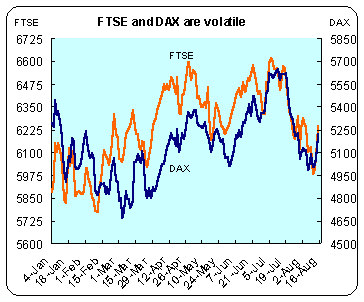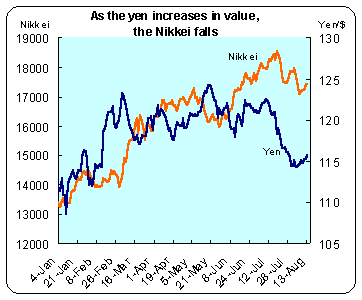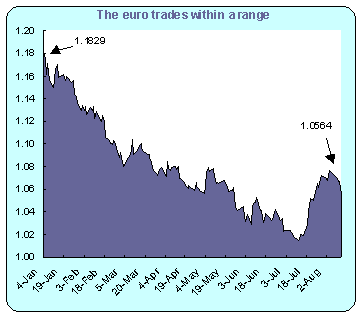
|
Today's Calendar |
| | Simply Economics |
| | International Perspective |
| | Resource Center |
 |
|
| 1999 Articles |
|
International Perspective August 16, 1999
Good News in Europe and Asia
Europe The focus now is how to turn the recovery into sustained growth. There are three reasons for optimism.
The data provide the proof Even though industrial production was unchanged in June, output is expected to pick up strongly based on the jump in manufacturing orders and the business optimism as expressed in recent sentiment surveys. The difference indicates that there is a greater lag between orders and production than analysts expected. An indication that consumers are beginning to participate in the upturn came in the form of German retail sales. They rose 2.4 percent seasonally adjusted and 3.5 percent on the year, underlying recent signs of a pickup in the German economy. The United Kingdom's unemployment rate, at 4.3 percent, is the lowest since March 1980. The drop highlights Britain's two track economy with sharp growth in the service sector and continued hardship for manufacturers. Like the United States, manufacturers are feeling the affects of a strong currency, which cuts into export sales. Service employment continued to rise while manufacturing employment continued to drop. Retail sales in the United Kingdom also grew faster than analysts had expected. The Bank of England issued its quarterly inflation report last week. Market players study the report in order to gauge future monetary policy. Most importantly for the market, the report contains the Bank's expectations for growth and inflationary trends. Since the Bank's Monetary Policy Committee is bound to an inflation target of 2.5 percent in its monetary policy making role, no stone is left unturned to understand the inputs to the decision making process by committee members. In the inflation report, the Bank said that the immediate outlook is for growth with low inflation, but that the balance of inflationary risks had moved slightly to the upside. The Bank also acknowledged that Britain's recovery seemed more firmly entrenched, but there were still some downside risks, mostly from weaker world output. Like the United States, weak world prices and a strong currency helped to subdue inflation over the past two years.
Asia Japanese bankruptcies fell for the ninth straight month in July as government backed loan guarantees helped small companies avert failure. Corporate failures have steadily fallen since the government introduced a system of loan guarantees in October to curb bankruptcies at small companies, which were suffering as banks cut lending. Underlining the continuing improvement in business sentiment, an Economic Planning Agency (EPA) survey indicated that Japanese companies were "less gloomy" in the second quarter than they were in the first quarter. To sum up, the indicators last week were by and large encouraging and pointed to the continuing economic recovery of key world economies. Since many of the needed structural reforms are not yet in place, investors will have to continue to use caution when considering alternative investments outside the United States.
World Stock Exchanges Higher interest rates are a double edged sword. They make dollar deposits more attractive by paying a higher interest rate. However, they could hurt bonds and stocks and reduce demand for the U.S. currency. Inflation erodes bond values while the higher rates needed to contain inflation add to borrowing costs and pull down earnings and stocks. Investors selling U.S. securities often convert the dollar proceeds into other currencies. That could hurt the dollar, and a falling dollar in turn, could discourage global investors from putting the money in U.S. assets because of eroding value.
Below is an illustration of just how jumpy the British FTSE and German DAX indexes have been and how their movements parallel each other. 
How the Nikkei and yen interact  Foreign investors have been largely responsible for the 29 percent gain in the Nikkei average since the beginning of 1999. Few analysts believe that the rally is sustainable unless local investors begin to participate. U.S. investors think that if individual investors come back into the market, it will bolster the Japanese market recovery and push the broad market higher.
Currencies Heightened political tensions in Asia also are working to the dollar's advantage. Tensions with North Korea over threats of a long range missile test combined with the mounting tensions between China and Taiwan could easily rattle the markets. The dollar would once again be looked upon as a safe haven for investors should tensions escalate. 
Why U.S. investors care With the August 24th FOMC meeting fast approaching, the Fed, in addition to U.S. economic concerns, needs to consider the impact of higher U.S. interest rates on countries just beginning to recover from recession or slow growth. By making investments more attractive in the United States, these countries fear that investment funds that would otherwise be invested in their economies will be attracted elsewhere because of higher rates. Looking Ahead The following indicators will be released this week.
Release dates are subject to change. |
||||||||||||||||||||||||||||||||||||||||||||||||||||||||||||||||||||||||||||||||||||||||||||||||||||||||||||||||||||||||||||||||||||||||||||||||||||||